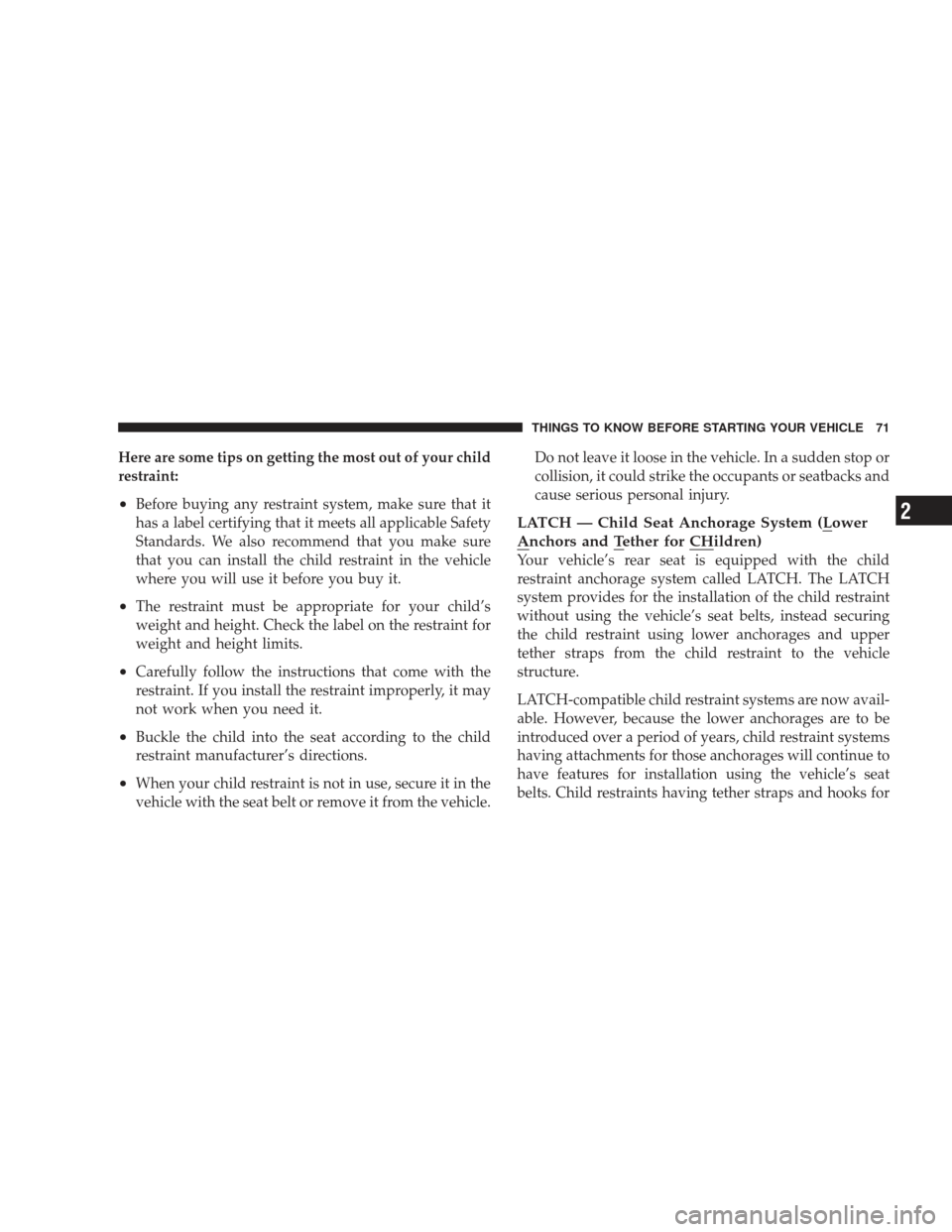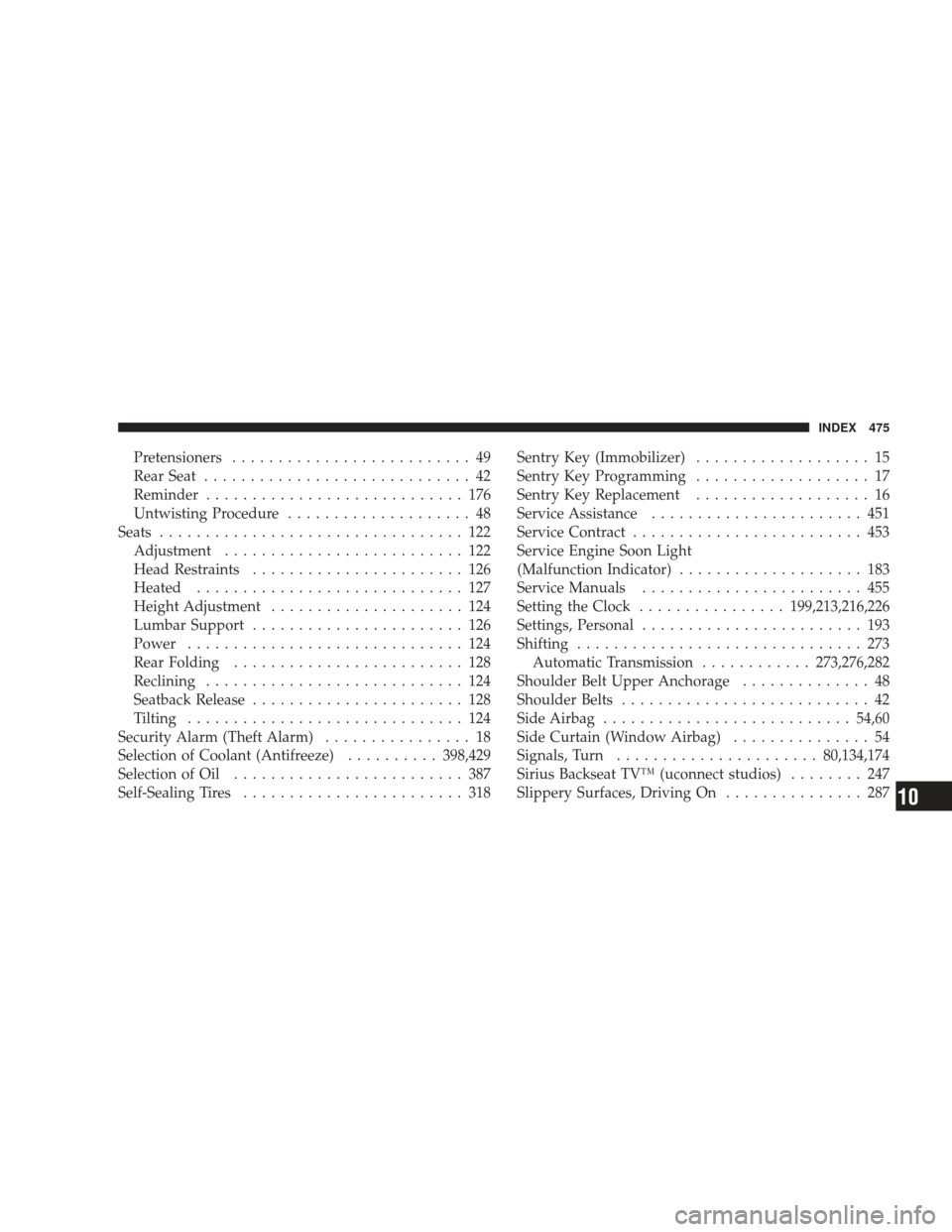Page 73 of 484

Here are some tips on getting the most out of your child
restraint:
•Before buying any restraint system, make sure that it
has a label certifying that it meets all applicable Safety
Standards. We also recommend that you make sure
that you can install the child restraint in the vehicle
where you will use it before you buy it.
•The restraint must be appropriate for your child’s
weight and height. Check the label on the restraint for
weight and height limits.
•Carefully follow the instructions that come with the
restraint. If you install the restraint improperly, it may
not work when you need it.
•Buckle the child into the seat according to the child
restraint manufacturer’s directions.
•When your child restraint is not in use, secure it in the
vehicle with the seat belt or remove it from the vehicle.Do not leave it loose in the vehicle. In a sudden stop or
collision, it could strike the occupants or seatbacks and
cause serious personal injury.
LATCH — Child Seat Anchorage System (Lower
Anchors and Tether for CHildren)
Your vehicle’s rear seat is equipped with the child
restraint anchorage system called LATCH. The LATCH
system provides for the installation of the child restraint
without using the vehicle’s seat belts, instead securing
the child restraint using lower anchorages and upper
tether straps from the child restraint to the vehicle
structure.
LATCH-compatible child restraint systems are now avail-
able. However, because the lower anchorages are to be
introduced over a period of years, child restraint systems
having attachments for those anchorages will continue to
have features for installation using the vehicle’s seat
belts. Child restraints having tether straps and hooks for
THINGS TO KNOW BEFORE STARTING YOUR VEHICLE 71
2
Page 166 of 484
LOAD LEVELING SYSTEM — IF EQUIPPED
The automatic load leveling system will provide a level-
riding vehicle under most passenger and cargo loading
conditions.
A hydraulic pump contained within the shock absorbers
raises the rear of the vehicle to the correct height. It takes
approximately 1 mile (1.6 km) of driving for the leveling
to complete depending on road surface conditions.If the leveled vehicle is not moved for approximately
15 hours, the leveling system will bleed itself down. The
vehicle must be driven to reset the system.
164 UNDERSTANDING THE FEATURES OF YOUR VEHICLE
Page 305 of 484
Tire Sizing Chart
EXAMPLE:
Size Designation:
P= Passenger car tire size based on U.S. design standards
\b....blank....\b = Passenger car tire based on European design standards
LT = Light truck tire based on U.S. design standards
T = Temporary spare tire
31 = Overall diameter in inches (in)
215 = Section width in millimeters (mm)
65 = Aspect ratio in percent (%)
— Ratio of section height to section width of tire
10.5 = Section width in inches (in)
R = Construction code
—�R� means radial construction
—�D� means diagonal or bias construction
15 = Rim diameter in inches (in)
STARTING AND OPERATING 303
5
Page 345 of 484
![DODGE CHARGER 2009 6.G Owners Manual Gross Combination Weight Rating (GCWR)
The GCWR is the total permissible weight of your vehicle
and trailer when weighed in combination. (Note that
GCWR ratings include a 150 lbs [68 kg] allowance for DODGE CHARGER 2009 6.G Owners Manual Gross Combination Weight Rating (GCWR)
The GCWR is the total permissible weight of your vehicle
and trailer when weighed in combination. (Note that
GCWR ratings include a 150 lbs [68 kg] allowance for](/manual-img/12/5563/w960_5563-344.png)
Gross Combination Weight Rating (GCWR)
The GCWR is the total permissible weight of your vehicle
and trailer when weighed in combination. (Note that
GCWR ratings include a 150 lbs [68 kg] allowance for the
presence of a driver.)
Gross Axle Weight Rating (GAWR)
The GAWR is the maximum capacity of the front and rear
axles. Distribute the load over the front and rear axles
evenly. Make sure that you do not exceed either front or
rear GAWR.
WARNING!
It is important that you do not exceed the maximum
front or rear GAWR. A dangerous driving condition
can result if either rating is exceeded. You could lose
control of the vehicle and have an accident.
Tongue Weight (TW)
The TW is the downward force exerted on the hitch ball
by the trailer. In most cases, it should not be less than 10%
or more than 15% of the trailer load. You must consider
this as part of the load on your vehicle.
Frontal Area
The frontal area is the maximum height and maximum
width of the front of a trailer.
Trailer Sway Control
The trailer sway control is a telescoping link that can be
installed between the hitch receiver and the trailer tongue
that typically provides adjustable friction associated with
the telescoping motion to dampen any unwanted trailer
swaying motions while traveling.
Weight-Carrying Hitch
A weight-carrying hitch supports the trailer tongue
weight, just as if it were luggage located at a hitch ball or
some other connecting point of the vehicle. These kinds
STARTING AND OPERATING 343
5
Page 477 of 484

Pretensioners.......................... 49
Rear Seat ............................. 42
Reminder ............................ 176
Untwisting Procedure .................... 48
Seats ................................. 122
Adjustment .......................... 122
Head Restraints ....................... 126
Heated ............................. 127
Height Adjustment ..................... 124
Lumbar Support ....................... 126
Power .............................. 124
Rear Folding ......................... 128
Reclining ............................ 124
Seatback Release ....................... 128
Tilting .............................. 124
Security Alarm (Theft Alarm) ................ 18
Selection of Coolant (Antifreeze) ..........398,429
Selection of Oil ......................... 387
Self-Sealing Tires ........................ 318 Sentry Key (Immobilizer)
................... 15
Sentry Key Programming ................... 17
Sentry Key Replacement ................... 16
Service Assistance ....................... 451
Service Contract ......................... 453
Service Engine Soon Light
(Malfunction Indicator) .................... 183
Service Manuals ........................ 455
Setting the Clock ................ 199,213,216,226
Settings, Personal ........................ 193
Shifting ............................... 273
Automatic Transmission ............273,276,282
Shoulder Belt Upper Anchorage .............. 48
Shoulder Belts ........................... 42
Side Airbag ........................... 54,60
Side Curtain (Window Airbag) ............... 54
Signals, Turn ...................... 80,134,174
Sirius Backseat TV™ (uconnect studios) ........ 247
Slippery Surfaces, Driving On ............... 287
INDEX 475
10